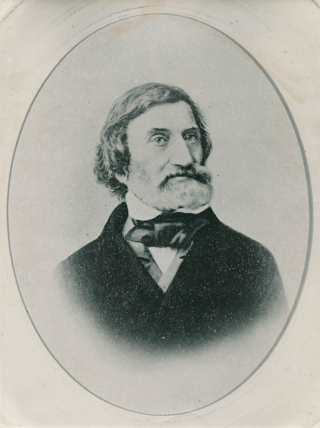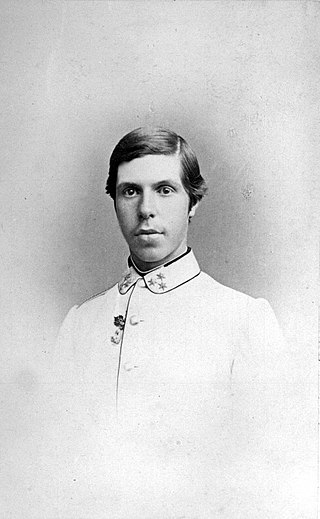
Ludwig Alois Friedrich Ritter von Köchel was an Austrian musicologist, writer, composer, botanist, and publisher. He is best known for cataloguing the works of Mozart and originating the 'KV-numbers' by which they are known.

Johann Ludwig Tieck was a German poet, fiction writer, translator, and critic. He was one of the founding fathers of the Romantic movement in the late 18th and early 19th centuries.

Friedrich Wilhelm Ludwig Leichhardt, known as Ludwig Leichhardt, was a German explorer and naturalist, most famous for his exploration of northern and central Australia.

Eduard Friedrich Mörike was a German Lutheran pastor who was also a Romantic poet and writer of novellas and novels. Many of his poems were set to music and became established folk songs, while others were used by composers Hugo Wolf and Ignaz Lachner in their symphonic works.

DieBrücke, also known as Künstlergruppe Brücke or KG Brücke, was a group of German expressionist artists formed in Dresden in 1905. The founding members were Fritz Bleyl, Erich Heckel, Ernst Ludwig Kirchner, and Karl Schmidt-Rottluff. Later members were Emil Nolde, Max Pechstein, and Otto Mueller. The seminal group had a major impact on the evolution of modern art in the 20th century and the creation of expressionism. The group came to an end around 1913. The Brücke Museum in Berlin was named after the group.

Ernst Ludwig Kirchner was a German expressionist painter and printmaker and one of the founders of the artists group Die Brücke or "The Bridge", a key group leading to the foundation of Expressionism in 20th-century art. He volunteered for army service in the First World War, but soon suffered a breakdown and was discharged. His work was branded as "degenerate" by the Nazis in 1933, and in 1937 more than 600 of his works were sold or destroyed.

Schwanengesang (Swan Song), D 957, is a collection of 14 songs written by Franz Schubert at the end of his life and published posthumously:
- Liebesbotschaft (text: Ludwig Rellstab)
- Kriegers Ahnung (Rellstab)
- Frühlingssehnsucht (Rellstab)
- Ständchen (Rellstab)
- Aufenthalt (Rellstab)
- In der Ferne (Rellstab)
- Abschied (Rellstab)
- Der Atlas (Heinrich Heine)
- Ihr Bild (Heine)
- Das Fischermädchen (Heine)
- Die Stadt (Heine)
- Am Meer (Heine)
- Der Doppelgänger (Heine)
- Die Taubenpost (alternative: D 965a) (Johann Gabriel Seidl)

Museum Ludwig, located in Cologne, Germany, houses a collection of modern art. It includes works from Pop Art, Abstract and Surrealism, and has one of the largest Picasso collections in Europe. It holds many works by Andy Warhol and Roy Lichtenstein.

Carl Ludwig Christian Rümker was a German astronomer.

Ludwig Borchardt was a German Egyptologist. He is best known for finding a famous bust of Nefertiti at Amarna.

The Museum of Biblical Art (MOBIA) was a museum in Manhattan, New York City, that closed in 2015.

Archduke Ludwig Salvator of Austria, was an Austrian archduke of the House of Habsburg who became known as a champion for Majorca's wildlife, in an era when the term "conservation" was not highly regarded. The Balearic Islands commemorated the centenary of the death of Archduke Ludwig Salvator during 2015.

Ludwig Meidner was a German expressionist painter and printmaker born in Bernstadt, Silesia. Meidner is best known for his painted, drawn, and printed portraits and landscapes, but is especially noted for his "apocalyptic" series of work featuring his stylized visions of a pending transformation of Germany before World War I.
Johann August Ludwig Preiss was a German-born British botanist and zoologist.

DukeMaximilian Joseph of Bavaria, known informally as Max in Bayern, was a member of a junior branch of the royal House of Wittelsbach who were Kings of Bavaria, and a promoter of Bavarian folk-music. He is most famous today as the father of Empress Elisabeth of Austria ("Sisi") and great-grandfather of King Leopold III of Belgium.

Mumok is a museum in the Museumsquartier in Vienna, Austria.
Ludwig Glauert MBE was a British-born Australian paleontologist, herpetologist and museum curator. He is known for work on Pleistocene mammal fossils, and as a museum curator who played an important role in natural science of Western Australia.

Ludwig II, also called the Swan King or the Fairy Tale King, was King of Bavaria from 1864 until his death in 1886. He also held the titles of Count Palatine of the Rhine, Duke of Bavaria, Duke of Franconia, and Duke in Swabia. Outside Germany, he is at times called "the Mad King" or "Mad King Ludwig".

The Römisch-Germanisches Zentralmuseum (RGZM), Leibniz Research Institute for Archaeology, is headquartered in Mainz. It is supported by the Federal Republic of Germany and its states and is a member of the Leibniz Association of German research institutions.

The 347 Series or 347 Suite is a series of etchings by the Spanish artist Pablo Picasso executed between March 16 and October 8 1968. The work was Picasso's largest in terms of the number of individual prints in the series; and his penultimate large etching series before the 156 Series of 1969-1972. It was dedicated to his friend Jamie Sabartes. No name was given by Picasso to the series. The 347 series was first displayed at the Art Institute of Chicago and Paris's Galerie Louise Leris in 1970.


















